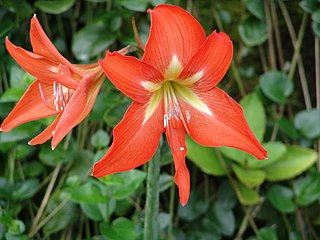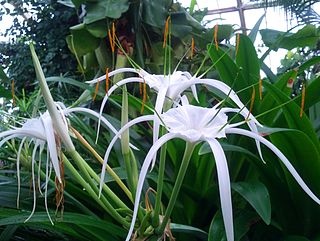
Hippeastrum is a genus of about 90 species, and over 600 hybrids and cultivars, of perennial, herbaceous and bulbous plants, native to tropical and subtropical regions of the Americas, from Mexico south to Argentina and on some islands in the Caribbean. The majority have large, fleshy bulbs—usually about the size of a softball—and tall, broad, strap-like leaves that are (generally) evergreen, and large red or purple flowers. Numerous colors and cultivars have been created over the past hundred years.

Hymenocallis (US) or (UK) is a genus of flowering plants in the amaryllis family native to the Americas.

Ismene amancaes, commonly called amancae or amancay, is a herbaceous plant species in the family Amaryllidaceae and native to the coastal hills of Peru.

Eucrosia is a genus of herbaceous, perennial and bulbous plants in the Amaryllis family distributed from Ecuador to Peru. The name is derived from the Greek eu, beautiful, and krossos, a fringe, referring to the long stamens. As circumscribed in 2020, the genus contains six species. Phaedranassa and Rauhia are the genera most closely related to Eucrosia.
Ocotea cuneifolia is a species of tree in the family Lauraceae that is native to Colombia, Ecuador, and Peru.

Pamianthe is a genus of South American bulbous perennials in the Amaryllis family, subfamily Amaryllidoideae. They can be found in sandy, but rocky areas in Colombia, Ecuador, Peru, and Bolivia.
Eucrosia eucrosioides is a species of flowering plant in the family Amaryllidaceae. It is found in south west Ecuador and north Peru. Its natural habitats are seasonally dry lowland areas.
Eucrosia mirabilis is a species of plant from Ecuador. In the original scientific description in 1869, it was believed to be from Peru, but there is little evidence it ever grew there. The plant disappeared from cultivation until it was found in Ecuador in 1997. Its natural habitats are seasonally dry lowland areas to elevations of 1500 m.

The Amaryllidaceae are a family of herbaceous, mainly perennial and bulbous flowering plants in the monocot order Asparagales. The family takes its name from the genus Amaryllis and is commonly known as the amaryllis family. The leaves are usually linear, and the flowers are usually bisexual and symmetrical, arranged in umbels on the stem. The petals and sepals are undifferentiated as tepals, which may be fused at the base into a floral tube. Some also display a corona. Allyl sulfide compounds produce the characteristic odour of the onion subfamily (Allioideae).

Oziroe is a genus of bulbous South American plants in the squill subfamily within the asparagus family. Within the Scilloideae, it is the sole member of the tribe Oziroëeae and the only genus in the subfamily to be found in the New World.

Stenomesson is a genus of bulbous plants in the family Amaryllidaceae. All the species are native to western South America.

Clinanthus is a genus of bulbous plants in the family Amaryllidaceae. It is found in western South America, including Ecuador, Peru, Bolivia, north Chile and north west Argentina.

Paramongaia is a genus of South American plants in the Narcissus Family ( Amaryllidaceae), the most important species being Paramongaia weberbaueri found only in the Andes of Peru and Bolivia. Common names are "giant Peruvian daffodil." and Cojomaria. Its appearance resembles the "King Alfred" Daffodil, but the flower is up to 7.25 inches in length by 7.5 inches wide with a corona 3.3 inches by 3 inches long by three inches wide.

Urceolina is a genus of South American plants in the amaryllis family native to Bolivia, Brazil, Colombia, Costa Rica, Ecuador, Guatemala, Panama, and Peru. It has also been introduced to many South and Central American states, as well as India and Sri Lanka. The formerly accepted genera Eucharis and Caliphruria are now regarded as synonyms of this genus. Many species of this genus share the common name Amazon lily.

Leptochiton is a genus of South American plants in the Amaryllis family.

Odontadenia is a genus of plant in the family Apocynaceae, first described as a genus in 1841. It is native to southern Mexico, Central America, South America, and the West Indies.
- Odontadenia anomala(Van Heurck & Müll.Arg.) J.F.Macbr. - Peru, Bolivia
- Odontadenia campanulataJ.F.Morales - Colombia
- Odontadenia funigeraWoodson - Venezuela, Colombia, Ecuador, Peru, Brazil
- Odontadenia geminata(Hoffmanns. ex Roem. & Schult.) Müll.Arg. - 3 Guianas, Venezuela, Colombia, Ecuador, Peru, Bolivia, N Brazil
- Odontadenia glaucaWoodson - Amazonas State in S Venezuela
- Odontadenia gracilipes(Stadelm.) Woodson - Minas Gerais
- Odontadenia hypoglauca(Stadelm.) Müll.Arg. - Bolivia, Brazil
- Odontadenia killipiiWoodson - French Guiana, Venezuela, Colombia, Ecuador, Peru, N Brazil
- Odontadenia kochiiPilg. - Guyana, Venezuela, Colombia, Ecuador, Peru, N Brazil
- Odontadenia laxiflora(Rusby) Woodson - Peru, Bolivia, N Brazil
- Odontadenia lutea(Vell.) Markgr. - Peru, Bolivia, Brazil
- Odontadenia macrantha(Roem. & Schult.) Markgr. - Oaxaca, Chiapas, Central America, Trinidad & Tobago, 3 Guianas, Venezuela, Colombia, Ecuador, Peru, Brazil
- Odontadenia markgrafianaJ.F.Morales - French Guiana, N Brazil
- Odontadenia matogrossanaJ.F.Morales - Goiás, Mato Grosso
- Odontadenia nitida(Vahl) Müll.Arg. - Trinidad & Tobago, 3 Guianas, Venezuela, Colombia, Ecuador, Peru, Brazil, Bolivia
- Odontadenia perrottetii(A.DC.) Woodson - Venezuela, Colombia, Brazil, Bolivia, Guyana, French Guiana
- Odontadenia polyneura(Urb.) Woodson - Hispaniola
- Odontadenia puncticulosa(Rich.) Pulle - Central America, 3 Guianas, Venezuela, Colombia, Ecuador, Peru, Brazil, Bolivia
- Odontadenia stemmadeniifoliaWoodson - Venezuela, Colombia, Ecuador, Peru, Brazil
- Odontadenia verrucosa(Willd. ex Roem. & Schult.) K.Schum. ex Markgr. - 3 Guianas, Venezuela, Colombia, Ecuador, Peru, Brazil, Bolivia, Panama, Costa Rica, Nicaragua
- Odontadenia cuspidataRusby = Mandevilla cuspidata(Rusby) Woodson
- Odontadenia duckeiMarkgr. = Mandevilla pohliana(Stadelm.) A.H.Gentry
- Odontadenia glandulosa(Ruiz & Pav.) K.Schum. = Mandevilla glandulosa(Ruiz & Pav.) Woodson
- Odontadenia macrocalyx(Müll.Arg.) Miers = Tabernaemontana macrocalyxMüll.Arg.

Hymenocallideae is a tribe, where it forms part of the Andean clade, one of two American clades. The tribe was originally recognised by both Meerow (1995) and the Muller-Doblies' (1996). Its phylogenetic position within the Amaryllidoideae was established by Meerow et al. in 2000, while in-depth infratribal relationships were established in 2002.

Stenomesson leucanthum is a species of flowering plant in the family Amaryllidaceae. It is native to Peru. Pierfelice Ravenna, the Chilean botanists who first formally described the species, using the basionym Pucara leucantha, named it after its white flowers.

















